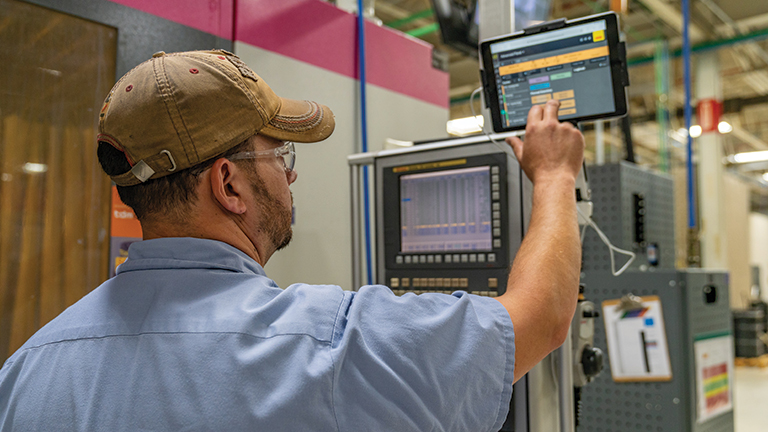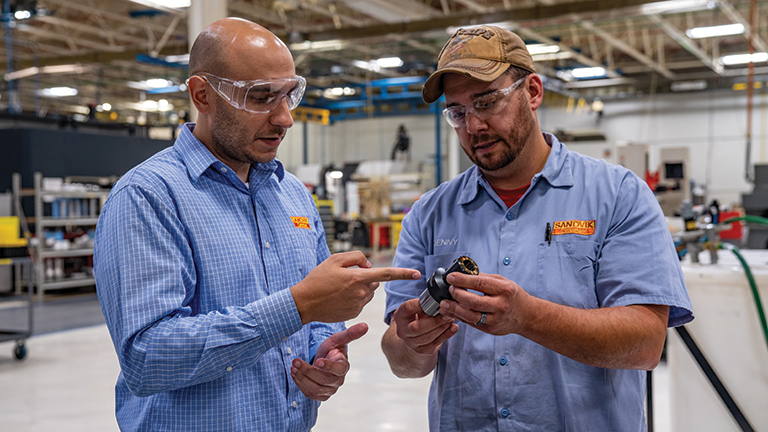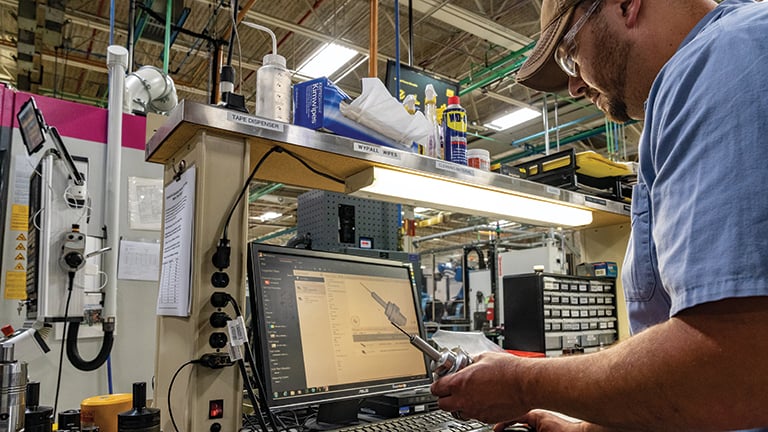Part 2: Where Machining and Industry 4.0 Meet

Part 1 of this three-part series on the Connected Machine Shop ran in the July issue of Manufacturing Engineering. That article showed how the Industrial Internet of Things (IIoT) increases visibility to shop floor activities, and how cloud-based production monitoring is superior to traditional paper-based data collection.
As discussed in that earlier story, change is hard. Still, you have to begin somewhere, so let’s start by asking: what’s the biggest pain point? Is it an unimpressive OEE figure (overall equipment effectiveness), a metric that might often be overestimated? Is it flagging part quality, or poor tool life, or disparate islands of information, or one too many machine crashes ? For Julio Vasconcelos, engineering manager for Sandvik Coromant’s production facility in Mebane, N.C., the difficulty was an all-too-common one: cycle times that were often much longer than predicted. It wasn’t until he and his team implemented the company’s machine monitoring software, MachiningInsights, that they discovered the root cause.
“We quickly learned that some of the operators were turning down the feed rate overrides in an attempt to solve problems and then leaving it there,” Vasconcelos said. “By having better visibility, we significantly increased machine utilization, and boosted tool life as well. We’ve since found similar examples, everything from operators waiting on first part inspection to the robot failing to load a part properly. In each instance, we had the operator enter reason codes or short descriptions of the problem. Because of these efforts, we’ve increased our OEE from 55 to 80 percent, which if you do the math, equates to an entire day of additional machine time each week.”
Get Brainstorming
Every shop is different, and yours might not have such low-hanging fruit. While most are rife with opportunities for continuous improvement, staff members might not agree on how to tackle them, nor have the tools to do so. What’s needed is an action plan that delineates what are the problems, the necessary action items, who’s responsible for each, and how much it will cost.
Perhaps the best place to start is by gathering everyone concerned and get brainstorming, sharing their production concerns, time-wasters, and pet peeves. Write them on a whiteboard. Rank each one, then look for common ground. Solicit suggestions on ways to eliminate these problems. Document what data is missing, its probable source, and how you’re going to collect it.

There should also be simple but effective methods to measure progress. This becomes much easier once data collection is automated. It is impossible to determine the effectiveness of any solution without clearly defined metrics. What are they? The KPIs that return the biggest bang for the buck.
Above all, understand this is not a side project, something to be done as time or budget permits. The goal should be a complete transformation of the business. That said, it’s okay to start small. Bijal Patel, senior digital machining specialist for Sandvik Coromant, suggested that during a recent Q&A on the company’s web site, offering a mantra along with the phrases “think big” and “scale rapidly.”
Building a Better Crib
If Jeff Rizzie were in the brainstorming session just described, the top of his pet peeve list might read “too much reliance on tribal knowledge.” The director of digital machining at Sandvik Coromant, he’s the first to agree that skilled, experienced people are a valuable commodity in any shop, but he also suggested that a) they will one day retire or take their knowledge elsewhere, and b) are far more effective when backed by intelligent software.
“Pretend for a minute that you’re a CNC programmer and your supervisor has just handed you a job,” Rizzie said. “You’ll probably start by selecting all your tools, which for most shops means grabbing a paper catalog. An experienced person has a pretty good idea what they need, but it still means leafing through hundreds of pages and SKUs by the tens of thousands until you’ve identified everything needed. You’ll then have to type the part numbers and dimensions into the CAM software, and probably have to go back to the catalog again for the feeds and speeds. Shops with a digital machining strategy can avoid all this. They can just drag and drop whatever’s needed to get the job done.”

Shops can also avoid the inevitable mistakes that arise from the manual, tribal knowledge approach. A shop that leverages an integrated tooling platform like Sandvik Coromant’s CoroPlus ToolLibrary, he said, has instant access to digital models of everything in the catalog, along with any associated metadata, such as procurement and usage information, storage locations, and substitute products.
The benefits are manifold. There’s no risk of fat-fingering a feed rate or spindle speed. Collisions are less likely, especially when used with toolpath simulation software and offline presetting. And because these systems are increasingly intelligent, they help guide users through the tool selection process. Programmers simply answer questions about their machining application and the software then presents the most suitable solutions. This saves time and reduces mistakes.
“Systems like these also provide a place to manage all cutting tool data,” Rizzie said. “You can have a virtual twin of every cutting tool, toolholder, screw, and shim in the tool crib, even if it didn’t come from Sandvik Coromant. And because the CoroPlus ToolLibrary is built on ISO standards, and has an open API (application programming interface), sharing information with other software is seamless.”
Homework Needed for I 4.0
There are a few prerequisites before all this digital wizardry can begin. The first is a networked shop. We’ll cover more of the “wires and pliers” aspect of Industry 4.0 in Part 3 of this series, but for now, the first task is to get the shop connected. Because solutions from Sandvik Coromant, along with most others, are cloud-based, robust connectivity is needed. That includes firewalls, anti-virus software, and operator training to keep assets secure.
There should also be some discussion of which software systems (even if they’re not yet purchased) will be the primary hosts of all this data, and which will be secondary. For example, the ToolLibrary that Rizzie mentioned could host all of the shop’s tooling data, with synchronization back to the ERP system (for procurement purposes) and CAM software (for programming and simulation).
Yet this data might also be stored in a tool management system (TMS), one that’s tied to an offline presetting unit and tool dispensing cabinets, with hooks back to the shop’s other software. And some might argue that product lifecycle management (PLM) or product data management (PDM) software is a better choice, as tooling information can then be stored alongside a workpiece’s other engineering-related data.
Which way to go depends on what systems are available, you

r shop’s unique data needs, and its Industry 4.0 vision. What’s most important, however, is that everyone is on board with the solution, and trained in its use. “That was critical for us,” said Vasconcelos. “Everyone wants to do a good job, and they’re happiest when they know they’re part of the solution.”
This is a good start on cutting tools, but what about the rest of the digital manufacturing strategy? After all, one of the primary deliverables of Industry 4.0 and the IIoT is the collection and analysis of production data, and that starts with CNC machine tools.
Assuming there is network connectivity, the next question is machine age. Older machines might need an aftermarket device. For shops with much older equipment, it’s something to look at early on in the project. The good news is that practically all newer CNC lathes, multitaskers, machining centers, and EDMs are connection ready.
Consider this—Vasconcelos and the team at Sandvik Coromant’s Mebane facility improved their OEE figures by monitoring a simple feed rate override. What insights might be gained by collecting data such as servo loads, spindle temperatures, tool usage, and macro variables, and then analyzing that data in the context of quality information (available from connected CMMs and gaging equipment) and operator input? Or using it to perform predictive maintenance? Improve scheduling accuracy? Reduce cycle times?
As Patel noted, this is possible. All that’s required is the willingness to change and a set of realistic expectations. “With all the talk over the past few years of Industry 4.0, some people have developed this Utopian vision of a connected machine shop, where there’s data streaming everywhere, there’s complete visibility to everything, and there are never any surprises,” he said. “The reality is that a lot of shops don’t even have an Internet connection. As an industry, we’re currently at the bicycle stage, while everyone’s dreaming of Teslas.”
Get On and Ride
Fortunately, we’re poised to reach the Tesla stage quickly. Patel noted that customers can connect their machines to MachiningInsights and start collecting data within minutes. The software will then present this data using preconfigured dashboards to anyone interested, and send email or SMS messages to those who’ve subscribed. And even if those same people are too busy to begin any in-depth continuous improvement projects based on that information, just having it available helps identify trends and troubleshoot problems, which in return reduces machine downtime.
“It’s a great way to get started with your digitalization efforts,” he said. “It’s cloud-based, so there’s no big investment in servers. Anyone with a login and the appropriate access rights can see what the machines are doing on any device. There’s no need for hours of data analysis because the software does all the heavy lifting for you. It just makes everything and everyone more efficient.”
Rizzie agreed with Patel’s bicycle analogy, offering a comparison to the soft drink industry, which has embraced IIoT practices for decades. These companies, Rizzie explained, have sensors everywhere. They enjoy complete visibility to the pumps, motors, gear trains, and every other component in their highly-automated production lines. They have service level agreements with the suppliers who manufactured those lines, and if the software used to monitor them predicts an imminent component failure, it is proactively serviced.
“We [in the machining industry] currently don’t do any of that,” Rizzie said. “The technology is available. It’s increasingly affordable, well understood, and relatively easy to implement. Despite all that, most machine shops don’t care. They wait for their equipment to break. They have the technology to monitor cutting fluid concentration and particulate levels but rely instead on how bad it smells before deciding to change it. They depend on gut feel and tribal knowledge to machine parts, rather than scientific methods and data. All of this needs to stop if the industry is to remain competitive. The tools are there for the taking; it’s just a matter of grabbing hold of them and getting started.”
In the third and final part of the Connected Shop series, we’ll explore a few of the more technical details of Industry 4.0, including cloud computing, integration, and communication protocols.
"machine" - Google News
August 24, 2020 at 07:11PM
https://ift.tt/3grmllo
The Connected Machine Shop - Advanced Manufacturing
"machine" - Google News
https://ift.tt/2VUJ7uS
https://ift.tt/2SvsFPt
Bagikan Berita Ini















0 Response to "The Connected Machine Shop - Advanced Manufacturing"
Post a Comment